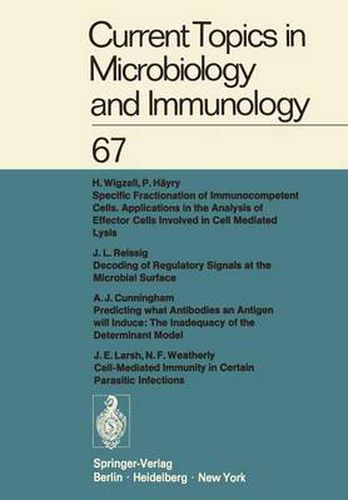Readings Newsletter
Become a Readings Member to make your shopping experience even easier.
Sign in or sign up for free!
You’re not far away from qualifying for FREE standard shipping within Australia
You’ve qualified for FREE standard shipping within Australia
The cart is loading…






This title is printed to order. This book may have been self-published. If so, we cannot guarantee the quality of the content. In the main most books will have gone through the editing process however some may not. We therefore suggest that you be aware of this before ordering this book. If in doubt check either the author or publisher’s details as we are unable to accept any returns unless they are faulty. Please contact us if you have any questions.
Prominent progress in molecular biology was only made when it became possible to separate functionally distinct molecules by taking advantage of their biophysical properties. Likewise, the analysis of the functions of hetero geneous populations of immunocompetent cells, as to the functional properties of their various subpopulations, can not be done until these can be isolated in reasonably pure form by selective fractionation. During the last few years significant advances have been made in this field, and cells have been separated according to size, density or charge (MILLER et aI. , 1969; SHORTMAN, 1968; ANDERSSON, 1973 c), or by taking advantage of more specific surface markers to allow selective depletion or enrichment of a given subpopulation of cells (WIGZELL and ANDERSSON, 1971). Although separation techniques have been used in a variety of cellular systems, they have been particularly useful in the study of reticuloendothelial cells and primarily in the study of cells partici pating in the immune responses. Quite extensive reviews have been written which well cover the methods used for separation of cells and the results obtained with the various approaches (WIGZELL and ANDERSSON, 1971; SHORTMAN, 1972). To review this work is becoming a more and more voluminous task. As data rapidly accumulate, we will not try to make such a complete review.
$9.00 standard shipping within Australia
FREE standard shipping within Australia for orders over $100.00
Express & International shipping calculated at checkout
This title is printed to order. This book may have been self-published. If so, we cannot guarantee the quality of the content. In the main most books will have gone through the editing process however some may not. We therefore suggest that you be aware of this before ordering this book. If in doubt check either the author or publisher’s details as we are unable to accept any returns unless they are faulty. Please contact us if you have any questions.
Prominent progress in molecular biology was only made when it became possible to separate functionally distinct molecules by taking advantage of their biophysical properties. Likewise, the analysis of the functions of hetero geneous populations of immunocompetent cells, as to the functional properties of their various subpopulations, can not be done until these can be isolated in reasonably pure form by selective fractionation. During the last few years significant advances have been made in this field, and cells have been separated according to size, density or charge (MILLER et aI. , 1969; SHORTMAN, 1968; ANDERSSON, 1973 c), or by taking advantage of more specific surface markers to allow selective depletion or enrichment of a given subpopulation of cells (WIGZELL and ANDERSSON, 1971). Although separation techniques have been used in a variety of cellular systems, they have been particularly useful in the study of reticuloendothelial cells and primarily in the study of cells partici pating in the immune responses. Quite extensive reviews have been written which well cover the methods used for separation of cells and the results obtained with the various approaches (WIGZELL and ANDERSSON, 1971; SHORTMAN, 1972). To review this work is becoming a more and more voluminous task. As data rapidly accumulate, we will not try to make such a complete review.